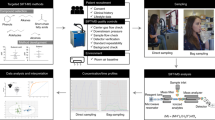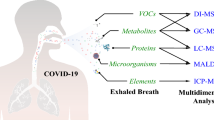Abstract
Interest in the use of GC-IMS for the detection of volatiles has seen a rapid expansion over the last decade. The following chapter will focus on classical GC-IMS and its research applications in the potential for diagnosis, rapid testing and biomarker discovery, with an emphasis on breath testing. Breath analysis via GC-IMS has enormous potential in many clinical areas including screening for pulmonary diseases, infections and toxins. Due to the technology’s small footprint, robustness in various environments and ease of use, there have been many studies looking at its potential utility in the clinical field, including its use as a screening tool for SARS-CoV-2 infections. There remain limitations to the device usage and data processing which are discussed throughout the chapter. An introduction to its fundamentals, standardisation, breath collection methods and active areas of research and development will be covered.
Access this chapter
Tax calculation will be finalised at checkout
Purchases are for personal use only
Similar content being viewed by others
Notes
- 1.
Note: The extensive review on the studies of those effects and the IMS principles in general, its history and applications and future perspective can be found in “Ion Mobility Spectrometry” by G.A. Eiceman, Z. Karpas, and Herbert H. Hill, Jr. [5] an important and complete reference on GC-IMS technique.
References
Cohen MJ, Karasek FW (1970) Plasma chromatographytm – a new dimension for gas chromatography and mass spectrometry. J Chromatogr Sci 8:330
Kanu AB, Hill Jr HH (2007) Identity confirmation of drugs and explosives in ion mobility spectrometry using a secondary drift gas. Talanta 73(4):692–699
Cohen MJ, Karasek FW (1970) Plasma chromatography™ – a new dimension for gas chromatography and mass spectrometry. J Chromatogr Sci 8(6):330–337
Revercomb HE, Mason EA (1975) Theory of plasma chromatography/gaseous electrophoresis. Review. Anal Chem 47(7):970–983
Eiceman GA, Karpas Z (2005) Ion mobility spectrometry. CRC Press
Davis C, Pleil J, Beauchamp J (eds) (2020) Breathborne biomarkers and the human volatilome
Daulton E et al (2021) Volatile organic compounds (VOCs) for the non-invasive detection of pancreatic cancer from urine. Talanta 221:121604
Tyagi H et al (2021) Urinary volatiles and chemical characterisation for the non-invasive detection of prostate and bladder cancers. Biosensors 11(11):437
Daulton E et al (2020) The detection of wound infection by ion mobility chemical analysis. Biosensors 10(3):19
Lacey L et al (2020) Detection of group B Streptococcus in pregnancy by vaginal volatile organic compound analysis: a prospective exploratory study. Transl Res 216:23–29
Drees C, Vautz W, Liedtke S et al (2019) GC-IMS headspace analyses allow early recognition of bacterial growth and rapid pathogen differentiation in standard blood cultures. Appl Microbiol Biotechnol 103:9091–9101
Fabio DF et al (2008) Implementation of Fowler’s method for end-tidal air sampling. J Breath Res 2(3):037009
Myers R et al (2022) Breath collection protocol for SARS-CoV-2 testing in an ambulatory setting. J Breath Res 16(2):027105
Ruszkiewicz DM et al (2022) Peppermint protocol: first results for gas chromatography-ion mobility spectrometry. J Breath Res 16(3):036004
Ghimenti S et al (2015) Comparison of sampling bags for the analysis of volatile organic compounds in breath. J Breath Res 9(4):047110
Vautz W et al (2014) GC/IMS and GC/MS analysis of pre-concentrated medical and biological samples. Int J Ion Mobil Spectrom 17(1):25–33
Horváth I et al (2017) A European Respiratory Society technical standard: exhaled biomarkers in lung disease. Eur Respir J 49:4
Henderson B et al (2020) A benchmarking protocol for breath analysis: the peppermint experiment. J Breath Res 14(4):046008
Wilkinson M et al (2021) The peppermint breath test: a benchmarking protocol for breath sampling and analysis using GC–MS. J Breath Res 15(2):026006
Hovda KE, Urdal P, Jacobsen D (2005) Increased serum formate in the diagnosis of methanol poisoning. J Anal Toxicol 29(6):586–588
Helge Hunderi O, Hovda KE, Jacobsen D (2006) Use of the osmolal gap to guide the start and duration of dialysis in methanol poisoning. Scand J Urol Nephrol 40(1):70–74
Kraut JA, Mullins ME (2018) Toxic alcohols. N Engl J Med 378(3):270–280. https://doi.org/10.1056/NEJMra1615295. Erratum in: N Engl J Med. 2019 Jan 10;380(2):202
“Ion mobility spectrometry in clinical setting” – talk given on 16th of February 2022 at RSC molecular spectroscopy group meeting
Phillips M et al (2013) Detection of volatile biomarkers of therapeutic radiation in breath. J Breath Res 7(3):036002
Salman D et al (2020) Breath markers for therapeutic radiation. J Breath Res 15(1):016004
Toxi-Triage. http://toxi-triage.eu
Okumura T et al (1996) Report on 640 victims of the Tokyo subway sarin attack. Ann Emerg Med 28(2):129–135
John H et al (2018) Fatal sarin poisoning in Syria 2013: forensic verification within an international laboratory network. Forensic Toxicol 36(1):61–71
(2018) Organisation for the prohibition of chemical weapons. Fact sheet 4. What is a chemical weapon? OPCW, The Hague
Tomassoni AJ, French RNE, Walter FG (2015) Toxic industrial chemicals and chemical weapons: exposure, identification, and management by syndrome. Emerg Med Clin 33(1):13–36
North CS, Pfefferbaum B, Vythilingam M, Martin GJ, Schorr JK, Boudreaux AS, Spitznagel EL, Hong BA (2009) Exposure to bioterrorism and mental health response among staff on Capitol Hill. Biosecur Bioterror: Biodefense Strat Pract Sci 7
Ruszkiewicz DM et al (2020) Diagnosis of COVID-19 by analysis of breath with gas chromatography-ion mobility spectrometry – a feasibility study. EClinicalMedicine 29:100609
Subali AD et al (2022) The potential of volatile organic compounds-based breath analysis for COVID-19 screening: a systematic review & meta-analysis. Diagn Microbiol Infect Dis 102(2):115589
Myers R (2022) Detection of mild SARS-CoV2 infection in out-patients. IABR breath summit 2022 Pisa, Italy
Nazareth J et al (2022) Discriminatory ability of gas chromatography-ion mobility spectrometry to identify patients hospitalised with COVID-19 and predict prognosis. medRxiv
Bannaga AS et al (2021) Exploratory study using urinary volatile organic compounds for the detection of hepatocellular carcinoma. Molecules 9:2447
Chen H et al (2021) COVID-19 screening using breath-borne volatile organic compounds. J Breath Res 15:047104
Ratiu IA et al (2020) Volatile organic compounds in exhaled breath as fingerprints of lung cancer, asthma and COPD. J Clin Med 10(1):32
Jiang D et al (2021) Breath-by-breath measurement of intraoperative propofol by unidirectional anisole-assisted photoionization ion mobility spectrometry via real-time correction of humidity. Anal Chim Acta 1150:338223
Heiderich S et al (2021) Correlation of exhaled propofol with Narcotrend index and calculated propofol plasma levels in children undergoing surgery under total intravenous anesthesia-an observational study. BMC Anesthesiol 21(1):1–9
Shokri H et al (2020) Field induced fragmentation (Fif) spectra of oxygen containing volatile organic compounds with reactive stage tandem ion mobility spectrometry and functional group classification by neural network analysis. Anal Chem 92(8):5862–5870
Shokri H et al (2021) Successive reactions in field induced fragmentation spectra from tandem ion mobility spectrometry at ambient pressure and their influence on classification by neural networks. Int J Mass Spectrom 470:116701
Acknowledgements
The authors would like to gratefully acknowledge: Prof. CL Paul Thomas from Loughborough University (UK) – coordinator of the Toxi-Triage project along with Prof. Michael Eddleston, Dr. Bill Nailon and Dr. Duncan McLaren (Edinburgh University UK and Western General Hospital Edinburgh) and Prof. Knut Erik Hovda (Norwegian National Unit for CBRNE Medicine and Oslo University Hospital Norway) – coordinators of the clinical studies for sharing data for this chapter. We also acknowledge the clinical research staff including Yvonee (Norway), Kareen Darnley (Edinburgh) and Dr. Chenery Lin from General Hospital in Jakarta (Indonesia) for their research/data contributions. We would also like to thank Dr. James Covington (Warwick University) for sharing his work on a data pipeline for GC-IMS processing.
Author information
Authors and Affiliations
Corresponding author
Editor information
Editors and Affiliations
Rights and permissions
Copyright information
© 2022 The Author(s), under exclusive license to Springer Nature Switzerland AG
About this chapter
Cite this chapter
Ruszkiewicz, D.M., Meister, A., Myers, R. (2022). Ion Mobility Spectrometry in Clinical and Emergency Setting: Research and Potential Applications. In: Weigl, S. (eds) Breath Analysis . Bioanalytical Reviews, vol 4. Springer, Cham. https://doi.org/10.1007/11663_2022_20
Download citation
DOI: https://doi.org/10.1007/11663_2022_20
Published:
Publisher Name: Springer, Cham
Print ISBN: 978-3-031-18525-0
Online ISBN: 978-3-031-18526-7
eBook Packages: Chemistry and Materials ScienceChemistry and Material Science (R0)




